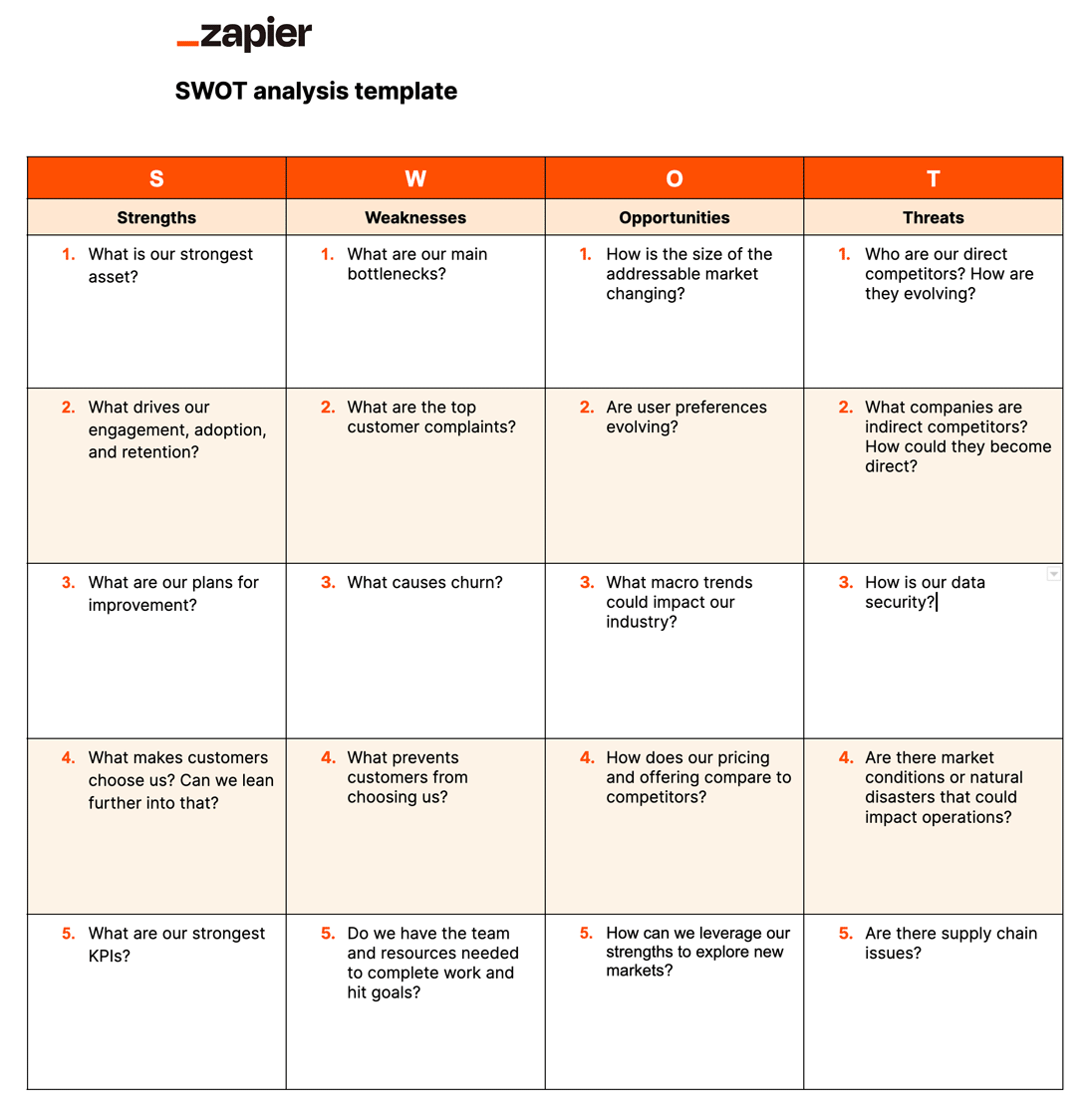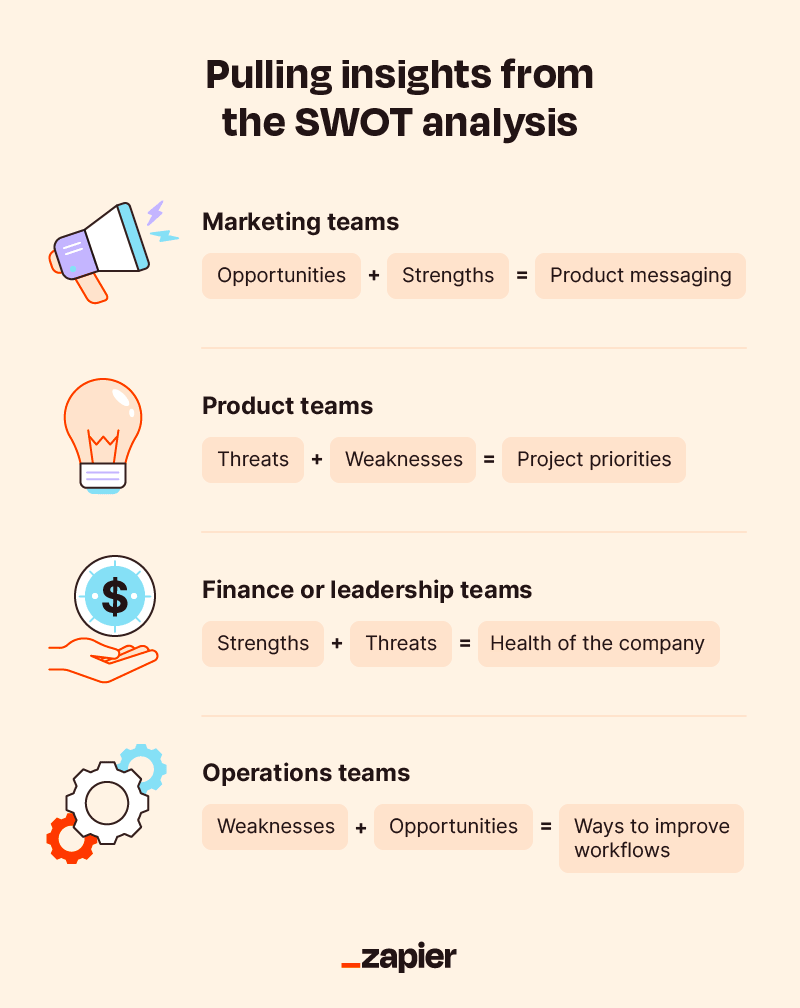Listen, I get it. The moment you hear "SWOT analysis," you start to tune out, think about what's for lunch today, and hope this discussion will be over soon. It makes sense, seeing as the only time most of us encounter SWOT is in some boring business textbook or on a vanilla LinkedIn post from a well-meaning manager named Craig.
While SWOT has a bland reputation, there's a reason businesses have used it for nearly 60 years. It's time to reclaim the strategy as something less snooze-worthy.
Table of contents:
What is a SWOT analysis?
A SWOT (Strengths, Weaknesses, Opportunities, and Threats) analysis is a strategic planning technique that helps businesses evaluate internal and external forces to gauge their current business and plan for the future. It's all about context, considering the positive and negative forces that a company contends with internally and externally.
Strengths (S) and weaknesses (W) relate to the company.
Opportunities (O) and threats (T) consider the industry and competitors.
Think of a SWOT analysis as a way to read the room, so you can make informed decisions. If you've ever prepped for a family gathering by tallying which cousins will be in attendance and what world events your uncle might rattle on, you've done a SWOT analysis.

How to do a SWOT analysis (+ an example)
A SWOT analysis is straightforward at the surface level. There are four boxes: one each for company strengths, weaknesses, opportunities, and threats.
The Harvard Business Review recommends looking externally first because that will give you more context to the relevance of everything internal. If you follow that method, you'll fill out the O and T boxes before S and W.
I'm going to use an example company (Midsize, Inc., a team collaboration app) to show the process in action. You can use this example to fill out the SWOT analysis template later.
1. Gather your intel
Compiling supporting data first makes it quicker to plug ideas into the template. Review project plans, check reports, analyze performance, or browse competitor websites.
Let's assume Midsize, Inc. has the following info handy:
Survey results to track user opinions
In-product analytics that reveal frustrating UX
A pricing comparison chart in a competitive analysis report
From here, I'll follow Harvard's advice and start the SWOT analysis from the outside.
2. Discover opportunities
Opportunities are conditions within your industry or niche that you can capitalize on. You don't need to take advantage of all of them, but seeing your options laid out can help you prioritize big initiatives.
Here are some example questions to gauge opportunities:
How is the size of the addressable market changing?
Are user preferences evolving?
What macro trends could impact our industry?
How do our offerings and pricing compare to competitors?
How can we leverage our strengths to explore new markets?
In a fast-moving industry, Midsize, Inc. can capitalize on opportunities like the following to enhance its position in the team collaboration app market:
Collaborating with other tech companies or forming partnerships with industry leaders to open up new avenues for growth
Expanding features within existing pricing tiers that competitors charge more for
3. Identify threats
Threats are ways that the competition could encroach on your market share. These generally fall into three camps: new competitors, competitor advancements, and industry trends.
Example questions to gauge threats include:
Who are our direct competitors? How are they evolving?
What companies are indirect competitors? How could they become direct?
How is our data security?
Are there market conditions or natural disasters that could impact operations?
Are there supply chain issues?
The tech industry is constantly evolving. Some ways this could put Midsize, Inc. behind include:
New entrants into the team collaboration space may introduce innovative solutions.
Changing user preferences and demands requires continuous adaptation to stay relevant.
Growing concerns around data breaches call for additional data security measures.
4. Consider strengths
After getting a sense of what's going on around your business, it's time for self-reflection. Strengths are ways your company stands out from the competition and meets customer needs.
Example questions to gauge strengths include:
What is our strongest asset?
What drives our engagement, adoption, and retention?
What are our plans for improvement?
What makes customers choose us? Can we lean further into that?
What are our strongest KPIs?
What skills does our team bring to the table?
Midsize, Inc. makes data-informed product and marketing decisions that give them a few competitive advantages, including:
High activation rates thanks to excellent customer onboarding
A new CEO who wants to focus on user satisfaction and retention
A growing product management team
5. Review weaknesses
The final component of the SWOT analysis is your company's shortcomings. Weaknesses are areas where your company falls short of customer expectations or operational efficiency.
Example questions to gauge weaknesses include:
What are our main bottlenecks?
What are the top customer complaints?
What causes churn?
What prevents customers from choosing us?
Do we have the team and resources needed to complete work and hit goals?
Like all companies, Midsize, Inc. has constraints that teams contend with. Their weaknesses include:
A recent reshuffling of the marketing team that put the department behind on a project
User frustrations with limitations within pricing tiers
Outdated help docs
SWOT analysis template
Use this SWOT template as a starting point. It includes guiding questions to follow and suggestions for how to pull actionable insights from your analysis.

When you should (and shouldn't) use SWOT
A SWOT analysis helps you understand your business and how it exists in context. That's powerful stuff, but it doesn't mean you should lean on this method in every scenario.
When to use SWOT analysis
You need a high-level view. You can apply SWOT to your entire company or focus on a niche, market, or department. Whichever level you choose, the analysis gives you a broad picture of conditions.
You have research to include. Your analysis will stand on firmer ground with quantitative or qualitative insights.
You need to decide on positioning (or prepare to pivot). Because SWOT looks internally and externally, it's helpful when you need to make big guiding decisions. Combining your competitors' shortcomings with your strengths is also an excellent product positioning opportunity.
When to skip the SWOT
You're the only one working on it. The point is to identify positives and negatives you aren't already aware of. You won't get the full effect if you create in a vacuum. Instead, get input from a diverse set of stakeholders across departments.
You want to understand one issue deeply. SWOT goes wide. It can tip you off to significant trends, but if you want to make a really specific decision, you'll need to go on a side quest.
You don't have a clear reason to do it. There needs to be something to prompt the SWOT, or else you may get lost in too many details. If there's a new competitor, your business is going in a new direction, or you're trying to understand why growth is stagnant, a SWOT makes sense. Otherwise, considering every contributing element could get overwhelming. You could use SWOT as part of an annual checkup, but it would still be helpful to have a few specific questions, goals, or concerns in mind.
Now what? Making decisions based on your SWOT
Simply filling out a SWOT analysis template might give you clarity on a problem you've been trying to solve. But applying a SWOT analysis might not look the same for every team.
For example:
The marketing team could combine opportunities and strengths to find new messaging.
The product management team could combine threats and weaknesses to prioritize additions or improvements.
The finance team or leadership might weigh strengths versus threats to gauge the company's health.
The operations team can combine weaknesses and opportunities to improve workflows.
No matter which segments pertain to your team, try to summarize a few takeaways at the end of the analysis. For our example company, Midsize, Inc., a takeaway could be refactoring pricing tiers to meet user needs and capitalize on industry opportunities or adding more automation to their workflows to help with marketing bottlenecks.

SWOT analysis: FAQ
Still think a SWOT analysis is nothing more than an annoying business school requirement? Here are answers to some common SWOT questions and dilemmas.
What are the benefits of a SWOT analysis?
A SWOT analysis:
Breaks down large problems into a manageable report
Uses internal and external factors to make well-informed decisions
Incorporates multiple data sources
Helps you set realistic goals
Identifies competitive advantages and market opportunities
Can be applied to multiple business facets
What are the 4 components of SWOT Analysis?
The four components of a SWOT analysis are Strengths, Weaknesses, Opportunities, and Threats.
Strengths cover internal attributes, capabilities, and resources that provide a competitive advantage.
Weaknesses represent internal limitations or areas in need of improvement.
Opportunities involve external factors and emerging trends that could create favorable conditions for growth and success.
Threats are external factors that could prevent progress or pose risks.
What are the biggest SWOT analysis mistakes?
Here are some of the biggest SWOT analysis mistakes, in the event you miraculously got by in college without having to do one:
Lack of objectivity: Ignoring research and data in favor of your assumptions or "gut feeling" negates the whole point of the exercise. Be honest about weaknesses, and let the data lead you.
Relying only on SWOT: A SWOT analysis is a great tool, but it can't be the only thing you use to make decisions. Incorporate it into a broader strategic planning process with additions like a PEST analysis or buyer personas.
Not validating findings: Don't run with data until you've verified it. Discussions, feedback, and data analysis can help you ensure accuracy and relevance.
Not taking action: If you type up this report and then never open the file again, you're doing it wrong. Identify the most critical findings from your report, prioritize them, and make an action plan.
A SWOT analysis gives you actionable takeaways for your business. But unlike business school, you don't have to do the whole process manually. Automate your competitor analysis to speed things up and keep a constant pulse on your market position.
Related reading:
This article was originally published in April 2022 by Steph Knapp. The most recent update was in August 2023.






